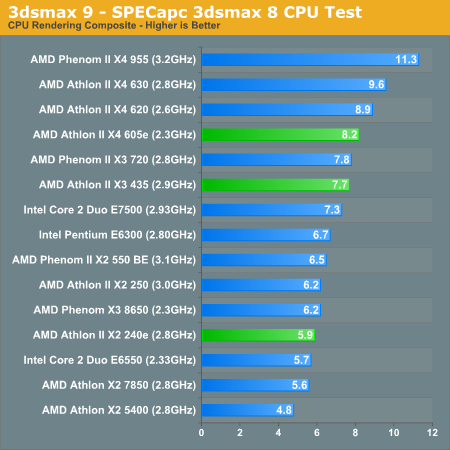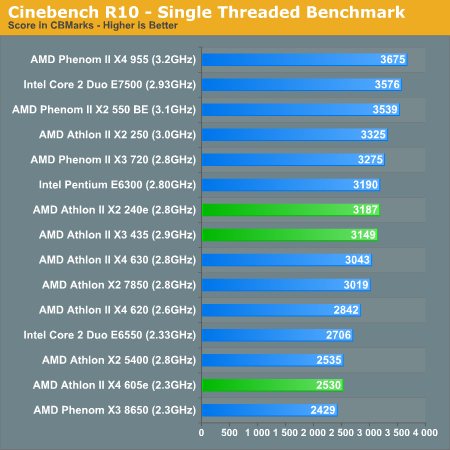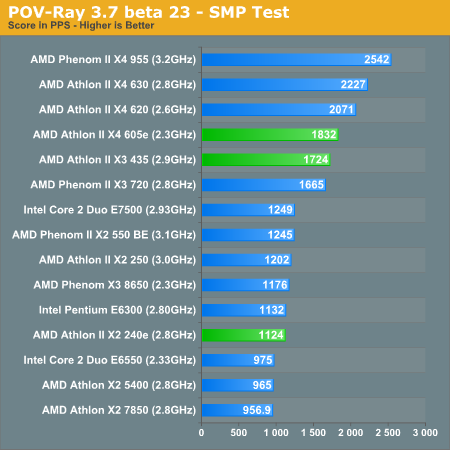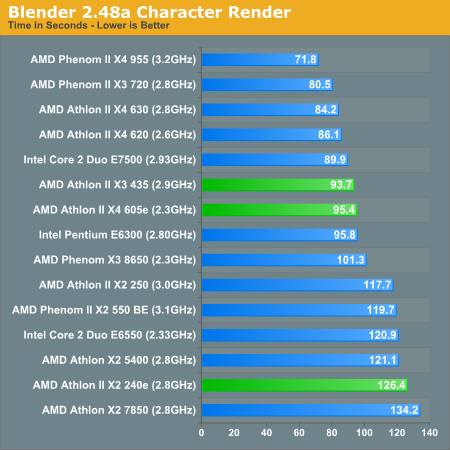AMD's Athlon II X3 435 & New Energy Efficient CPUs: Killing Intel Below $90
by Anand Lal Shimpi on October 20, 2009 12:00 AM EST- Posted in
- CPUs
3dsmax 9 - SPECapc 3dsmax CPU Rendering Test
Today's desktop processors are more than fast enough to do professional level 3D rendering at home. To look at performance under 3dsmax we ran the SPECapc 3dsmax 8 benchmark (only the CPU rendering tests) under 3dsmax 9 SP1. The results reported are the rendering composite scores:

Compared to the Intel dual-core options, the Athlon II X3 435 is a definite winner here. It's got the core count and clock speed to beat the old Penryn derivatives. Its biggest competition comes from its own family, the Athlon II X4 620 is the better buy here.
Cinebench R10
Created by the Cinema 4D folks we have Cinebench, a popular 3D rendering benchmark that gives us both single and multi-threaded 3D rendering results.

As I've been mentioning this entire time, the Athlon II X3 435 doesn't really sacrifice clock speed in its three-core configuration. At 2.9GHz even its single threaded performance is comparable to the Pentium E6300. Run a multithreaded app however and the performance goes from parity to leading:

POV-Ray 3.73 beta 23 Ray Tracing Performance
POV-Ray is a popular, open-source raytracing application that also doubles as a great tool to measure CPU floating point performance.
I ran the SMP benchmark in beta 23 of POV-Ray 3.73. The numbers reported are the final score in pixels per second.

The POV-Ray results echo what we've been seeing thus far, vs. Intel there's no contest - the 435 is the better value. Compared to the quad-core Athlon IIs however, the 435 isn't very good.
Blender 2.48a
Blender is an open source 3D modeling application. Our benchmark here simply times how long it takes to render a character that comes with the application.











177 Comments
View All Comments
- Tuesday, October 20, 2009 - link
YO Maddoctor is ANAND!!maddoctor - Tuesday, October 20, 2009 - link
No, I'm not Anand. Anand is Intel fanboy like me, because he know only Intel who can designed an approriate processor with powerful performance.formulav8 - Tuesday, October 20, 2009 - link
Enough already. Your an absolute pestSangueffusor - Tuesday, October 20, 2009 - link
Your trolling is retardedly hilarious. Please, comment as much as you can before you get banned. I like laughing at your posts.tech4tac - Tuesday, October 20, 2009 - link
If AMD can put out inexpensive Athlon II X4 600e series desktop parts and at 45 TDP, why can't they do the same for their mobile segment:Compared to Intel's mobile processor lineup, AMD's is rather embarrassing (AMD is just not in the game). If Intel can sell the I7-820QM @ 1.73GHz and I7-720QM @ 1.60GHz (45W TDP parts @ $546.00 and $364ea in 1K quantities) for the performance notebook market, then why isn't AMD using the Athlon II X4 600e series to form the basis for a Turion II X4 product. It'd probably be 1/2 the price but with competitive performance. They could probably even drop down the clockspeed a tad to get it in the 35W TDP range (i.e. same as Mobile C2D performance parts). Then, the only thing left to work on would be idle power consumption.
Even if there is no hypothetical Turion II X4, the 600e parts could do well in desktop replacement notebooks as-is. Besides supply issues, I can't imagine any other excuse... Just my 2 cents.
fineliner - Wednesday, October 21, 2009 - link
I realize that everytime when one of us mentions something good about AMD and bad about Intel the famous doctor will respond. Let's see if I got his attention now.Back to the topic, I think this is a very interesting point raised - AMD Quad parts in mobile. Athlon II X4 605e clocks at 2.3GHz, rated at 45W TDP. So following the logic, if AMD lowers the clocks to 1.6/1.8G, they could knock down the power to, maybe 25-35W TDP. Those are very nice product offerings to notebooks.
No idea why AMD does not release such parts. Engineering problem maybe? delays?... given their track record.
I would like to see AMD bringing affordable Quad core CPUs to notebook platforms, just like what they did to bring more affordable quad parts (Athlon II X4) to desktop. At the end of the day, some of us perfers AMD or Intel, but competition is the key! At least, it will offer certain degree of motivation to Intel to keep their mobile quad prices low (or lower).
Agreed that "Competition is the foundation of getting the best bang for the buck." Competition also keeps innovation going. So credits to both AMD and Intel to bring us ever faster and cheaper processors. If only Intel's left, I don't think I would see that happening.
phaxmohdem - Tuesday, October 20, 2009 - link
I don't see the performance being very competitive unless AMD can incorporate some clone of the Turbo Boost tech into their chips. However, I agree a cheaper quad core mobile alternative would benefit us all.maddoctor - Tuesday, October 20, 2009 - link
WTF, They could not design it properly. Only Intel smarter engineers can do that with the best semiconductor manufacturing in the world. Turbo Boost in Intel is the best competitive solutions to suppress the power consumption like Mooly Eden have said.maddoctor - Tuesday, October 20, 2009 - link
Yes, because AMD is not competitive both the cost and its products performance. Many people did not know about AMD because people believe Intel is the PC. With sucks marketing, it is not surpriced AMD will face bankruptcy and soon Anandtech will only review Intel products.GeorgeH - Tuesday, October 20, 2009 - link
I understand that you want to use your standard benchmarking setup, but measuring the power consumption of these chips with a GTX280 isn't all that helpful when you consider that the vast majority of these chips are going to be paired with an IGP.It'd be nice if you could pick just one (say one of the XXXe chips) and throw it in a 780G or 785G motherboard and then measure its power consumption. From there we could extrapolate how much power the GTX280 is using to see how “Energy Efficient" these chips are in more real world setups. Saving 10-20W in the 150-200W range isn’t nearly as big of a deal as it is in the 50-100W range.